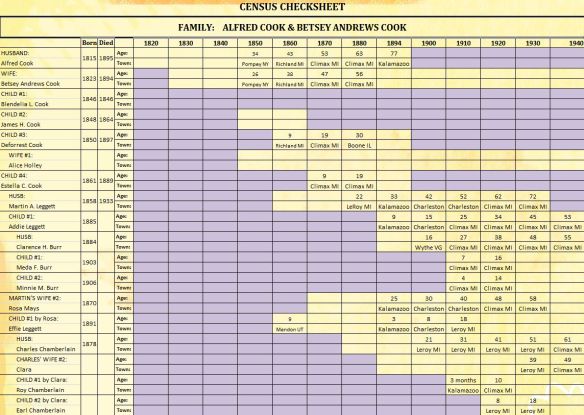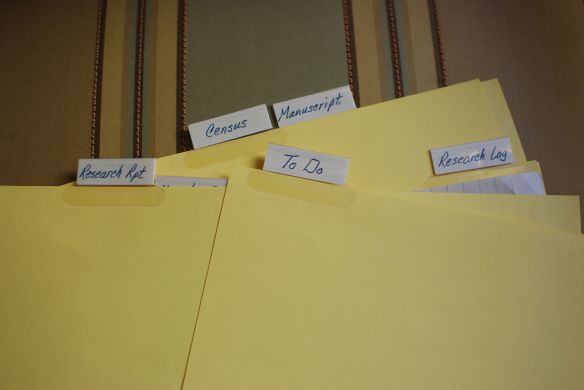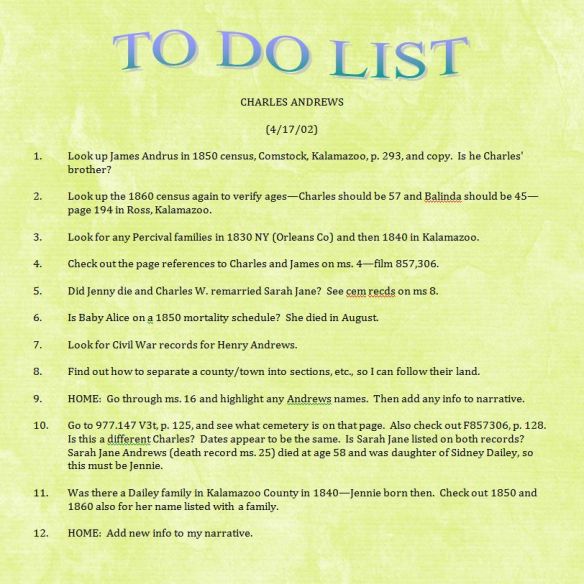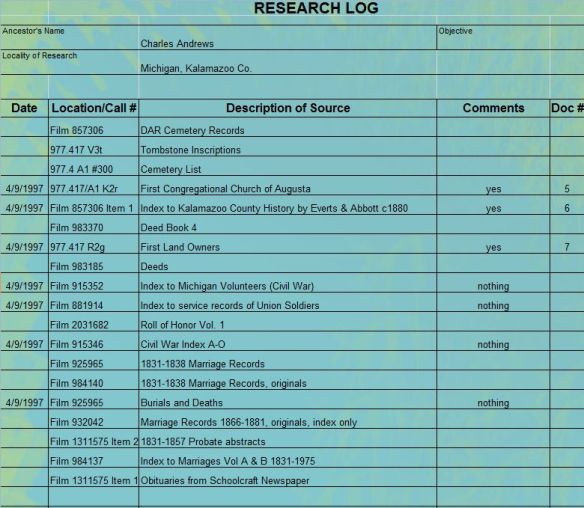ORGANIZING & UTILIZING A GENEALOGY RESEARCH NOTEBOOK
(my favorite use of a 3-ring binder)
I learned about this research notebook from a LDS Family History Consultant, Jayare Roberts. In the 30+ years since I took his class, I have changed this method very little. When I finish research on a family, this essentially provides me with a family history complete with index, sources, and documents.
If you want to research exclusively from your computer and have no need for hard copies, this method is probably not for you. I like to work with hard copies as I research. I transfer the information to the computer when I am finished.
Here’s how it works:
Use a 3-ring binder for each family. If the binder gets too big and you have accumulated a lot of info on the children, separate the children into their own binders. You may also end up with “in-law” binders. Separate the families out as much as needed, but for beginning research keep the family together. Buy a set of ten divider pages with plastic tabs for each notebook. (I often just make my own using old file folders. I can trim them to the size I want and make the divider tabs any size.)
Set up the dividers and put them in the research notebook in this order:
- To Do List
- Research Report
- Maps/Reference Material
- Correspondence
- Chronology/Narrative
- Pedigree Chart
- Family Group Record
- Census
- Research Log
- Manuscript
Here is a description of what goes behind each divider that creates the magic of your research notebook:
- As you think about records you should find or questions you have, jot them down on the To Do List. The next time you research, your To Do List is ready.
2. Every time you perform any research on the family, take a few minutes when you are finished to record what you did. Also record your thoughts, questions, feelings, everything that comes to mind about the family. It is so helpful when you pick up the book the next time, even if it is ten years later. It is also interesting to follow your research journey and becomes a research book of instructions for your posterity.
3. As you accumulate maps of the area or info about the towns and counties, put them in this section for future reference.
4. Correspondence includes letters, emails, posts on genealogy websites, anything that can be considered correspondence between you and another person. I keep these chronological by the person I am corresponding with. I also make sure addresses and phone numbers are recorded here for quick lookup.
5. A simple timeline of the family is a good way to start. As you find more information, the timeline may become more involved. Eventually you may want to turn this timeline into a narrative. I will give you an example of how to do this in a future post.
6. I like to keep a pedigree going both ways, ancestors and descendants, so I can see how this family fits into mine.
7. There are many family group record forms available on the internet. Pick one you like for research purposes. Or print out a blank family group record from your genealogy program. This is a place where you can quickly pencil in the information you find so you can see quickly what you have. Eventually you will want to transfer this information to the genealogy program on your computer.
8. I keep census records separate from the other research and I like them at the beginning of my research because I refer to them so often. I start with a census checklist. I will give you a couple of examples of these in a future post. I then include hard copies of all the census records in chronological order.

One of several census checksheets I have created over the years. I think I’m also addicted to spreadsheets.
9. The research log is the heart, or the magic, of this notebook. This is where you record every record you want to look at and every record you find. You can fill out a research log in advance if you are going to a research library by accessing their online catalog and recording the books and films that may have applicable documents. When you go to the library, your list of items is all ready and you don’t waste precious time accessing the catalog. (You should also use a research log for online research. However, I find this goes so quickly that I really have to discipline myself to write down every website I access.) The research log should contain the name of the record, the call number or film number, the date you looked for it, whether or not you found anything, and the document number you assigned to the records you found. These document numbers are assigned in order, no matter what the document is. If you found the death record first, it is #1. If you found the birth record next, it is #2. If you found a letter written to a cousin, it is #3. This is the beauty of the method – it is simple, quick, and then easy to find the document later. Make sure that you note “nothing” if the record you were looking at contained nothing on your family. This will ensure that you don’t look at the record again.
10. The manuscript section is where you put hard copies of the actual documents you find. If you find the death record first and have assigned it #1, write a “1” in the upper right hand corner of the document and put it behind “Manuscript.” When you find the second document, put a “2” in the upper right hand corner and file it in the notebook next. You can see that eventually you will have a notebook full of records with page numbers on them that will correspond to your index (research log). It is really a genius way of keeping everything accounted for.
By using this method, if your research is interrupted (and it will be), you can pick up your notebook again in six months and begin where you left off. Your research reports will jog your memory. Everything stays nice and neat and you can find any piece of info in seconds. Someone else can even take your notebook to the library and pick up where you left off. I think it’s MAGIC! If I have not made myself clear, please post your questions and I will explain in more detail.






Great information in this post.
LikeLike
WOW!! Thank you for posting this! What a great way to organize. I only THOUGHT I was doing good at organizing my stuff. Is there any way you would share your spreadsheet templates?
LikeLike
We have spent the last four months in the process of moving and I am just barely getting my office set up again and finding all my stuff! I am really close to being able to put up another post and will include some templates. If I forget to do that, ring my bell again. My new office looks totally different and the organization includes some new ideas. I am excited to put them out there.
LikeLike
Thank you for this! I am just a mess of boxes and folders and binders, and this makes a lot of sense. I repeat tasks all of the time as I tackle things months apart, this is very helpful.
LikeLike
So glad you received some inspiration. My family laughs at my over-organized life, but it works and ends up saving lots of time, especially with genealogy research. Stay tuned for more tips!
LikeLike
Hi! I just found your blog and love it! I also love the 2 forms that you created-Research Checklist and the Census one. Would you mind sharing the templates you created? I am impressed with detail and work you put into them. Have a nice day, Judy
LikeLike
Your magical system is intuitive and organized. I’ve been struggling (without satisfaction) to “fit” my research into the structure of one of the major software programs.I’m definitely going to try your system – it feels right!
LikeLike
I hope it helps. I was spending far too much time organizing and reorganizing, but with this system I never have to do that. Let me know how it works for you – and let me know if you need any templates. I make lots of them to fit what I’m researching, but I’m glad to share.
LikeLike
Oh no. Not again. I’ve organized and reorganized so many times, but this sure makes sense. I’ve gotten overwhelmed with my genealogy. I’ve been trying to work all of my lines at the same time and that just hasn’t worked so well. I have backed up and decided to focus on just one line at a time until everything is totally organized and documented. Thanks for posting this.
LikeLike
I feel your pain! I sometimes modify this notebook structure to fit what I’m doing, but it has really withstood the test of time. Good luck in your efforts!
LikeLike
Hi,I just found your website and was hoping & just wondering if you had a chance to create your spreadsheet templates for sharing? All of your information is so helpful, I am “re-organizing” my files and need all the help I can get.
Thank you Norma
LikeLike
I will email the forms to you. I still have no idea how to put them on my blog and make them interactive!!!
LikeLike
I would love to have your Census template.
LikeLike
Would love a copy of your templates. I have come to a standstill and records are a big mess. Your way sounds much more simple than what I have been doing.
Thanks Kim
LikeLike
They are coming by email. Thanks for your interest. Let me know anything else that would help and I probably have a form for it!
LikeLike
Same here! This is one of the only census checklists that feels ‘good’ for me! Many of them are more of a long list of individuals listed by census year…but I really like how you’ve identified each family first, then listed each person, husband wife, child, then their spouse and future children,…and where they are found on census records. Looks wonderful! If possible, I would love to view a template as well!
LikeLike
It seems I use a similar research log, but am curious as to what details your templates have that mine don’t. Would you mind sharing them with me? Also, how do you deal with mulitple generations of the same last name? Thanks in advance.
LikeLike
Thanks for your interest. All of the templates are shown on the blog. The research log can be downloaded from FamilySearch or Ancestry. Each head of household has a research notebook, so even if there is more than one person with the same name, you can find a way to identify them on the spine of the notebook, maybe by adding a date of birth or something. I actually have only once had two notebooks with the same name – John Wilcox and his son, John Wilcox II.
LikeLike
As I am starting to trace my family history this is the best thing I have found. Thanks for sharing
LikeLike
I have used this method for about 30 years and I still like it, have never changed a thing about it!
LikeLike
I found the link to this article on Pintetest. Your organising method is awesome, thanks for sharing. I do something similar, but as well set out as you. Also, I use lever arch files instead of 3 ring binders as its easier to add pages especially towards the back. I would love to have copies of your templates.
LikeLike
Great post on research notebook – I need this organization!! Buried in stuff and bogging down. Could you email me your templates? Especially the census template, seems so intuitive. Thanks so much.
Reinspired!
LikeLike
I am emailing it now. Please let me know if you have other areas you need organized and I’ll see if I have something that helps.
LikeLike
I love your organizational ideas! I’ve been trying to figure out how to easily keep track of what census records I’m missing, and you template is exactly what I need! Could you please e-mail it to me? It would make my day!
Thank you so much!
LikeLike
Thanks for sharing, I also would love the template for the census you created. Your organization skills is top notch! 🙂
LikeLike
I LOVE your research notebook and the templates, especially the census one. I am starting a Do Over and think this will help keep me focused on one goal at a time. Could you please send me a copy of your templates? Thank you for this awesome blog!
LikeLike
Thanks for your interest. I tried to email some templates to you, but they were undeliverable to the address on the blog.
LikeLike
I just found your post! I love the organizational ideas and I would love to have a template of your Census Records. That looks so helpful.
LikeLike
I too would like a copy of your great census templates. They will be very helpful.
LikeLike
I have emailed the forms to you. Thanks for your interest.
LikeLike
I love your blog…so much good info. Could you please email me your templates especially the Census template? Thanks…
LikeLike
I just found your blog. I’m starting over and would love to have your template.
Thanks.
LikeLike
I’m helping s friend redo her family history binders and had no clue how to make them intuitive until u found this past. Thank you for all your efforts and hard work.
I would like the templates as well, if you please.
What a blessing this is to have found your post!
LikeLike
The forms have been emailed to you. Thanks for your kind words.
LikeLike
As many have already said, your method seems to be excellent, simple and easy enough to be understood by most any genealogy collection heritor. If not a dang bother, would you send me your templates too. Or point me to a share file you may have in Google Docs, DropBox or equivalent? May I ask if you connect your paper system to your genealogy program in any way? By reference? By scanning your paper proofs? By linking scans to PC/Mac program? Just thinking your binder system appears so streamlined and understandable if it linked somehow hybrid manual/electronic or by both digitization and paper- I could convert to your system then die breathing leaving the binders and my laptop to my genealogy heritor aka my youngest son!
LikeLike
I will email you the templates. When I find any document I first scan/save it to my computer. I then print it and put it in the binder. For binders I created “before computers” I scanned all the pages and saved them on the computer. These documents are also attached to the correct people on my genealogy software (I use Legacy). If I had not saved any of this on my computer already, the task of scanning and saving would be daunting to be sure. Check out Shotbox if you need to scan whole binders of information. And I’m sure your youngest son is going to be THRILLED!!!
LikeLike
Wow, interesting.. Thank you for sharing your ideas. Funny thing.. I live in Comstock in Kalamazoo, Michigan. Hope you found something.
LikeLike
I would love a copy of your templates as well. With the census spreadsheet, how do you decide which family to start with? Thanks in advance!
LikeLike
Hello, I just found your site. Your organizational ideas seem great, and I can’t wait to try them. May I also have copies of your templates, especially the census? I can never find one that I like, but I like yours. Thank you.
Email- MarsFlower819@yahoo.com
LikeLike
I have sent the forms to you. Feel free to change and rearrange to fit your needs.
LikeLike
Just getting to get all my many many many items organized and found your site. So helpful, and would love your templates if you don’t mind sharing. Cinmatt2016@gmail.com Thank you
LikeLike
Found you by accident…on Pintrest…and am very much interested in following your blog! Is there a sign up somewhere that I missed? And I too am super interested in receiving your templates if at all possible. Many,many thanks! Leila
LikeLike
I found your post on Pinterest. Would you mind sharing your forms with me? I have so many notes and charts scattered, that I am aiming to get organized! Greatly appreciate your article!
LikeLike
Please send me an email address where I can send the forms.
LikeLike
Please send forms to:
lhughes1099@gmail.com
Thank you.
LikeLike
I just stumbled across your post on Pinterest and found it very helpful!
I would love to have a copy of the census template you developed and other forms you have found continue to be helpful.
Thank you very much
Ruth ruthvangerpen@gmail.com
LikeLike
I did something like this when I was helping my cousin find his birth parents, but it wasn’t this nicely organized.
I’m fixing to start digging to see if I can find out who hubbys 0grandmother’s grandmother. And I will give this a whirll.
LikeLike
only because you can’t edit a comment.
The only thing that your system doesn’t have is a space for DNA stuff.
LikeLike
Oh, and if you’re still sharing forms … sfarmer@goldsword.com
Thannks!
LikeLike